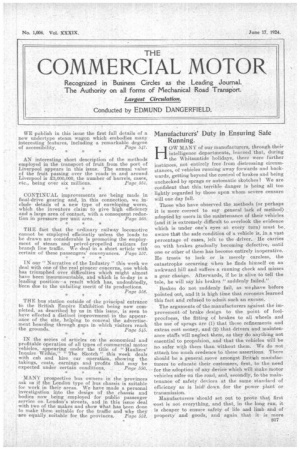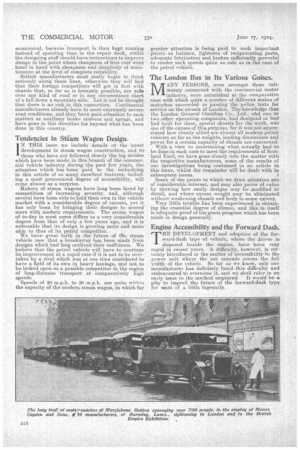Manufacturers' Duty in Ensuring Safe - Running.
Page 1

Page 2

If you've noticed an error in this article please click here to report it so we can fix it.
H. OW MANY of our manufacturers, through their intelligence departments,. learned that, during the Whitsuntide holidays, there were further instances, .not entirely free from distressing circumstances, of vehicles running away forwards and backwards, getting beyond the control of brakes and being unchecked by sprags or automatic sketches l We are confident that this terrible danger is being all too lightly regarded by those upon whom severe censure will one day fall. .
: Those who have observed the methods (or perhaps it is more correct to say general lack of method) adopted by users in the maintenance of their vehicles (and it is extremely difficult to overlook the evidence which is under one's eyes at every turn) must be• aware that the safe condition of a vehicle is, in a vast percentage of cases, left to the driver. He carries on with brakes gradually becoming defective, until one or other of them has become entirely inoperative. He trusts to luck or is merely careless, the catastrophe occurring when he finds himself on an awkward hill and suffers a running check and misses a gear chaAge. Afterwards, if he is alive to tell the tale, he will say his brakes " suddenly failed."
Brakes do not suddenly fail, as we phave before pointed out, and it is high time that coroners learned this fact and refused to admit such an excuse.
The arguments of the manufacturers against the im-. provenaentof brake .design to the point of fool. proofness, the fitting of brakes to all wheels and the use of sprags are (1) that these refinements and extras cost money, and (2) that drivers and maintenance staffs will neglect them, as they do anything not essential to propulsion, and that the vehicles will be no safer with them than without them. We do not attach too much credence to these assertions. There should be a general ,,move amongst Britich manufacturers to educate their customers, first, to the need -'for the adoption of any device which will make motor vehicles' safer on the road, and, secondly, to the maintenance of safety devices at the same standard of efficiency as is laid down for the power plant or transmission.
Manufacturers should set out to proVe that first "cost 'is not everything, and that, in the long run, it is cheaper to ensure safety of life and limb and of property' and goods, and' again that it is more economical, because transport is then kept running instead of spending time in the repair dock, whilst the designing staff should have instructions to improve design to the point where cheapness of first cost went hand in hand with cheapness and simplicity of maintenance at the level of complete reliability. British manufacturers must really begin to think seriously .along these lines, otherwise they will find that their foreign competitors will get in first with chassis that, so far as is humanly possible, are safe Over any kind of road Or in any circumstance short of a fall down a mountain-side. Let it not be thought that there is no risk in this connection_ Continental Manufacturers already have to meet extremely severe road conditions, and they have paid attention to such matters as auxiliary brake systems, and sprags, and have gone in this direction far beyond what has been done in this country.
Tendencies in Ste'am Wagon Design.
IN THIS issue we include details of the latest development in steam wagon construction, and to those who have not followed closely the big strides which have been made in this branch of the commercial vehicle industry during the past few years, the attention which has been paid to the embodying in this article of so many excellent features, including a most pronounced degree of accessibility, will come almost as a surprise. Makers of steam wagons have long been faced by competition of increasing severity, and, although several have been able to hold their own in the vehicle market with a considerable degree of success, yet it has only been by bringing their designs to accord more with modern requirements. The steam wagon of to-day in most cases differs to a very considerable degree from that of only a few years ago, and it is noticeable that its design is growing more and more akin to that of its petrol competitor. We have great faith in the future of the steam vehicle now that a. breakaway has been made from designs which had long outlived their usefulness. We believe that the petrol vehicle will have to continee its improvement at a rapid rate if it is not to be overtaken by a rival which was at one time considered to have a field of its own in heavy haulage, and not to be looked upon as a possible competitor in the region of long-distance transport at comparatively high speeds. Speeds of 20 m.p.h. to 30 m.p.h. are quite within the capacity of the modern steam wagon, in which far greater attention is being paid to such important points as balance, lightness of reciprocating parts, adequate lubrication: and brakes sufficiently powerful to render such speeds quite as safe as in the case of
the petrol vehicle. .
The London Bus in Its Various Guises. .
ANY PERSONS, even amongst those intl
. mutely connected with the commercial motor
industry, were astonished at the comparative ease with which quite a number of different makes of motorbus succeeded in passing the police tests for service on the streets of London. The knowledge that the London General Omnibus Co., Ltd., afid one or two other operating companies, had designed or bad hadimilt for them,. special chassis for the work, was one of the causes of this surprise, for it was not appreciated how closely allied are almost all modern petrol vehicles so far as the weights, leading dimensions and power for a certain capacity of chassis are concerned_ With a view to ascertaining what actually had to be done in each case to meet the requirements of Scotland Yard, we have gone closely into the matter with the respective manufacturers, some of the results of our investigations being contained in an article in this issue, whilst the remainder will be dealt with in subsequent issues. 4 4orne of the points to which we draw attention are of considerableariterest, and may also prove of value by showing how easily designs may be modified in detail, and where excess -weight may be eliminated without weakening chassis and body to some extent_ Very little trouble has been experienced in -obtaining the essential degree of silence, and this in itself is adequate proof of the great progress which has been made in 'design generally.
EngineAccessibility and the Forward Dash.
THE DEVELOPMENT and adoption of the for-. ward-dash type of vehicle, where the driver is disposed beside the engine, have been very rapidin recent' years. A difficulty, however, is certainly introduced-in the matter of accessibility to the power unit where the cab extends across the full width of the vehicle. So far as we know, only one manufacturer has definitely faced this difficulty and endeavoured to overcome it, and we hall refer in an early issue to the method employed. It would be a pity to imperil the future of the forward-dash type for want of a little ingenuity.
































